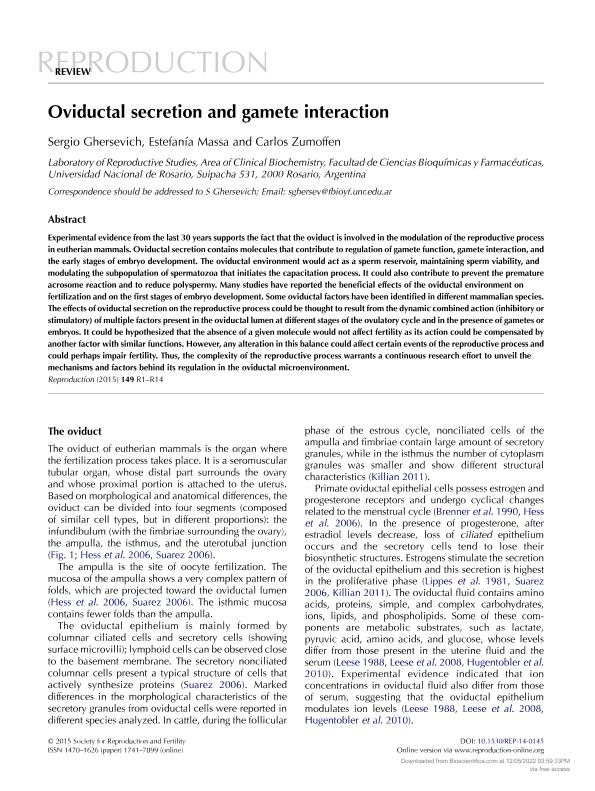Mostrar el registro sencillo del ítem
dc.contributor.author
Ghersevich, Sergio Albino

dc.contributor.author
Massa, Estefanía María Alejandra

dc.contributor.author
Zumoffen, Carlos María

dc.date.available
2022-12-05T16:17:47Z
dc.date.issued
2015-01
dc.identifier.citation
Ghersevich, Sergio Albino; Massa, Estefanía María Alejandra; Zumoffen, Carlos María; Oviductal secretion and gamete interaction; BioScientifica; Reproduction; 149; 1; 1-2015; 1-14
dc.identifier.issn
1470-1626
dc.identifier.uri
http://hdl.handle.net/11336/180208
dc.description.abstract
Experimental evidence from the last 30 years supports the fact that the oviduct is involved in the modulation of the reproductive process in eutherian mammals. Oviductal secretion contains molecules that contribute to regulation of gamete function, gamete interaction, and the early stages of embryo development. The oviductal environment would act as a sperm reservoir, maintaining sperm viability, and modulating the subpopulation of spermatozoa that initiates the capacitation process. It could also contribute to prevent the premature acrosome reaction and to reduce polyspermy. Many studies have reported the beneficial effects of the oviductal environment on fertilization and on the first stages of embryo development. Some oviductal factors have been identified in different mammalian species. The effects of oviductal secretion on the reproductive process could be thought to result from the dynamic combined action (inhibitory or stimulatory) of multiple factors present in the oviductal lumen at different stages of the ovulatory cycle and in the presence of gametes or embryos. It could be hypothesized that the absence of a given molecule would not affect fertility as its action could be compensated by another factor with similar functions. However, any alteration in this balance could affect certain events of the reproductive process and could perhaps impair fertility. Thus, the complexity of the reproductive process warrants a continuous research effort to unveil the mechanisms and factors behind its regulation in the oviductal microenvironment.
dc.format
application/pdf
dc.language.iso
eng
dc.publisher
BioScientifica

dc.rights
info:eu-repo/semantics/openAccess
dc.rights.uri
https://creativecommons.org/licenses/by-nc-sa/2.5/ar/
dc.subject
GAMETES
dc.subject
FERTILIZATION
dc.subject
PROTEINS
dc.subject
OVIDUCT
dc.subject.classification
Biología Reproductiva

dc.subject.classification
Ciencias Biológicas

dc.subject.classification
CIENCIAS NATURALES Y EXACTAS

dc.title
Oviductal secretion and gamete interaction
dc.type
info:eu-repo/semantics/article
dc.type
info:ar-repo/semantics/artículo
dc.type
info:eu-repo/semantics/publishedVersion
dc.date.updated
2022-12-05T15:09:48Z
dc.journal.volume
149
dc.journal.number
1
dc.journal.pagination
1-14
dc.journal.pais
Reino Unido

dc.description.fil
Fil: Ghersevich, Sergio Albino. Universidad Nacional de Rosario. Facultad de Cs.bioquímicas y Farmaceuticas. Departamento de Bioquímica Clinica. Bioquímica Clinica; Argentina
dc.description.fil
Fil: Massa, Estefanía María Alejandra. Universidad Nacional de Rosario. Facultad de Cs.bioquímicas y Farmaceuticas. Departamento de Bioquímica Clinica. Bioquímica Clinica; Argentina. Consejo Nacional de Investigaciones Científicas y Técnicas. Centro Científico Tecnológico Conicet - Rosario; Argentina
dc.description.fil
Fil: Zumoffen, Carlos María. Universidad Nacional de Rosario. Facultad de Cs.bioquímicas y Farmaceuticas. Departamento de Bioquímica Clinica. Bioquímica Clinica; Argentina
dc.journal.title
Reproduction

dc.relation.alternativeid
info:eu-repo/semantics/altIdentifier/doi/http://dx.doi.org/10.1530/REP-14-0145
Archivos asociados
